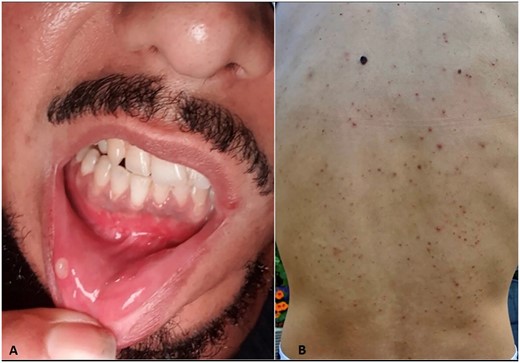-
PDF
- Split View
-
Views
-
Cite
Cite
Pareen Desai, Khaled Aldoub, Ali S Jawad, Multiple tooth extractions triggering Behçet’s disease, Rheumatology, Volume 60, Issue 3, March 2021, Pages e90–e91, https://doi.org/10.1093/rheumatology/keaa479
Close - Share Icon Share
Tooth extraction may cause a flare up or even trigger Behçet’s in a predisposed individual.
Sir, A 37-year-old Turkish Cypriot man presented with very painful several large and herpetiform mouth ulcers (Fig. 1A). A week prior to this, he had three wisdom teeth extracted and a pin and plate removed from his mandible at the same time under general anaesthetic. Seven years previously, he had a traumatic fracture of the mandible requiring a pin and a plate. The surgeon decided to remove the plate because it was no longer needed.

(A) Several large and herpetiform mouth ulcers. (B) Acneiform rash on the back.
There was also dehiscence of the surgical wounds and they had to be re-sutured three times. He was given two courses of antibiotics as a precaution.
Three weeks later, he developed acne like eruption on his back (Fig. 1B), red tender annular lesions on both shins and his left eye became painful with blurred vision, but he did not seek medical help. The left eye settled spontaneously after 3 weeks. Two weeks later, the right eye became painful and red with loss of vision. He was seen by the local ophthalmology department. A diagnosis of bilateral vitritis with possible optic neuritis was made. In view of the mouth ulcers, the rash and the bilateral vitritis, a diagnosis of Behçet’s disease was made. He was later found to be HLA-B51 positive. He was started on 60 mg prednisolone and CS eye drops. Within a couple of weeks his vision improved, the mouth ulcers healed and the rash receded. AZA was added.
When he was seen in our clinic the patient was very well, with hardly any mouth ulcers; the acneiform rash was minimal and the erythema nodosum on the shins had cleared, leaving faint pigmentations. Ophthalmological examination showed a quiescent left eye but a few cells in the right eye. Prior to the surgical procedure, he only complained of the occasional mouth ulcer. He was also known to have beta thalassemia trait.
We found seven cases of exacerbation or aggravation of pre-existing Behçet’s disease induced by tooth extraction (supplementary Table S1, available at Rheumatology online) [1–5]. The onset of symptoms usually occurs within 10 days; the mechanism is not clear. It has been suggested that good control of the disease prior to tooth extraction may prevent flare up [5].
We believe our patient is the first case report of new disease, rather than flare, to have been precipitated by the surgical procedure. He had three teeth extracted and a pin and plate removed under general anaesthetic. We believe that the severe surgical trauma was a significant factor in precipitating the disease. We postulate that trauma to the mucous membrane of the mouth perhaps is the initiator in our patient, who is predisposed to the disease because of his ethnicity and carrying the HLA-B51 gene.
Physicians and dentists should be aware that tooth extraction may cause a flare up or even trigger Behçet’s in a predisposed individual.
Funding: No specific funding was received from any funding bodies in the public, commercial or not-for-profit sectors to carry out the work described in this manuscript.
Disclosure statement: The authors have declared no conflicts of interest.
Supplementary data
Supplementary data are available at Rheumatology online.




Comments